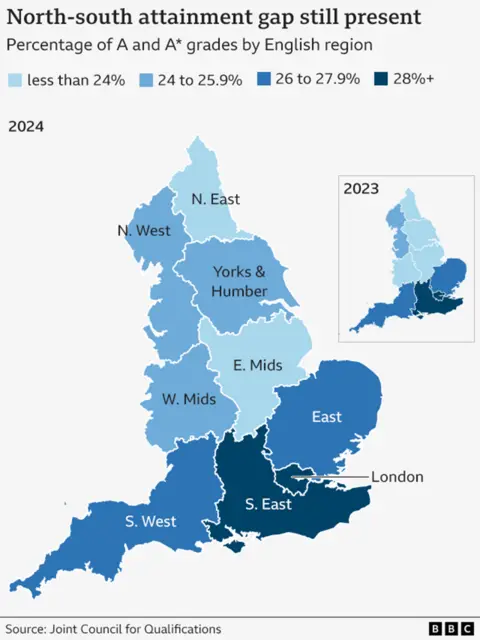 Good footage
Good footageLastly, after 5 years of adjusting approaches to exams and grading, that is it.
That is the 12 months that A-level grades throughout England, Wales and Northern Eire have roughly returned to the place they had been earlier than Covid.
Most college students get their tertiary leads to Yr 9 after the epidemic begins.
They had been the primary 12 months group to take a seat GCSEs in particular person after the Covid lockdowns, and there have been some additional measures to assist them, akin to advance info on subjects to revise.
Nonetheless, this 12 months, that additional assistance is gone and the strategy to grading stays the identical if the exams are by no means cancelled.
Right here's what you could know.
1. Higher grades rise general
Throughout England, Wales and Northern Eire, prime grades have risen for the primary time since 2021 – with 27.8% of all grades marked at A* or A.
That is 27.2% increased than final 12 months.
Outcomes for particular person international locations inform a extra advanced story, nevertheless, with higher leads to England however much less so in Wales and Northern Eire.
The proportion of A-levels marked at A* and A this 12 months:
- 27.6% in England, 26.5% in 2023
- 29.9% in Wales, down from 34%
- 30.3% in Northern Eire, down from 37.5%
Some college students in Wales and Northern Eire might really feel dissatisfied, however the story right here is larger than particular person efficiency.
Since exams had been canceled in 2020 and 2021 and selections based mostly on academics' evaluations, efforts have been made in recent times to deliver excessive requirements again to pre-pandemic ranges.
Within the UK, examination regulation goals to return to final 12 months's 2019 ranges (though they’re barely increased).
However in Wales and Northern Eire, the plan was at all times that this 12 months can be the second when requirements fell again to pre-Covid ranges.
In all three international locations, the share of first grades is increased this 12 months than in 2019 at 25.4%.
It ought to be borne in thoughts that not like final 12 months's A-level college students, these children have expertise of sitting exterior exams earlier than this 12 months and their examination outcomes are based mostly on their A-level coursework.

2. England's north-south divide persists
General, 27.6% of A-level grades in England had been awarded A* or A this 12 months.
However the price varies relying on the place you reside, and regional variations persist.
The hole between the 2 areas with the best and lowest charges of A* and A grades is widening yearly, and is even wider than it was earlier than the pandemic.
In London, the best performing area this 12 months, 31.3% of all grades had been marked A* or A, whereas the East Midlands, the bottom performing area this 12 months, had 22.5%.
Extra broadly, we nonetheless see a north-south divide – one thing that existed earlier than the pandemic, and has worsened over Covid.
This 12 months, the Midlands and plenty of areas within the north have improved at the next price than these within the south. The North East and West Midlands noticed the largest development in excellent grades.
Schooling Secretary Bridget Phillipson mentioned it was “too usually the case” that the place you come from determines what you possibly can obtain.
“We noticed gaps that opened up below the final Conservative authorities when it got here to regional variations,” he mentioned.
“There's a pity we now have to do.”
MPs warned final 12 months that the hole between deprived college students and others might take a decade to slim to pre-Covid ranges.

3. Math is an enormous winner
There was no change within the prime 10 hottest topics this 12 months.
However maths is the true winner – not solely is it the most well-liked topic but, it's additionally the primary A-level to surpass 100,000 entries.
Amongst all topics with greater than 10,000 entries, additional development was seen in Arithmetic, Physics, Computing, Arithmetic after which English Literature.
(Entries to the system have grown by 83.1% since 2019.)
Nonetheless, it’s worrying that boys make up nearly all of college students in most science, know-how, engineering and arithmetic (STEM) programs.
A report final week by the Nationwide Belief for Academic Analysis, commissioned by the British Academy, beneficial a variety of topics for younger individuals to check after the age of 16.
It mentioned there was a selected decline in development in arts and humanities topics, with 38% of sixth type college students taking a humanities topic in 2021-22, up from 60% in 2016.
All of this could ring alarm bells for universities attempting to recruit sufficient college students to maintain arts and humanities packages open.

4. D-level dropout price is excessive
It’s the third 12 months that outcomes have been launched for T-levels in England – the technical qualification created below the Conservative authorities that entails splitting time between classroom studying and industrial placements.
The dropout price stays excessive. Final 12 months, 66% of D-level college students accomplished their research.
This 12 months's retention price is great at 71%, however decrease than that for A-levels in England, which is constantly above 90%.
Based on Ms Phillipson, that is essential as T-levels are “right here to remain”.
“We need to be certain D-levels succeed,” he mentioned.
“The final authorities blocked disclosure and there are a lot of elementary points we need to handle.”
5. Success for college candidates
This can be a good 12 months for making use of to school, with 82% of candidates touchdown their first alternative.
Figures from the Universities and Faculties Admissions Service present that 376,470 candidates – of all ages and from all locations – had been accepted on their “definitive” check – a 4% rise on final 12 months.
Extra individuals bought prime A-level grades this 12 months, however there's additionally an enormous background right here.
Universities say they want extra funding. Based on the Workplace for College students, 40% of them in England are prone to be in deficit.
Tuition charges for home college students have been roughly frozen since 2012, dropping their actual time worth as a consequence of inflation.
To make up for the loss in funding, universities have been recruiting worldwide college students for years, paying increased charges. Nonetheless, current modifications to visa guidelines and the forex disaster in Nigeria are anticipated to result in a decline within the variety of worldwide college students beginning at UK universities subsequent month.
All of this implies universities want to extend their funding – and a part of that features enrolling extra home college students.
Extra reporting by Rob England, Invoice Leake and Muskeen Lidar


